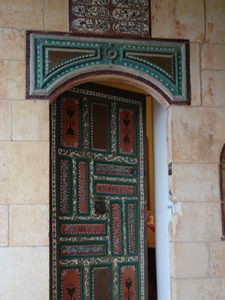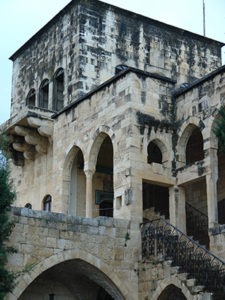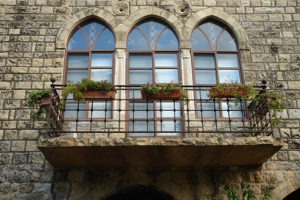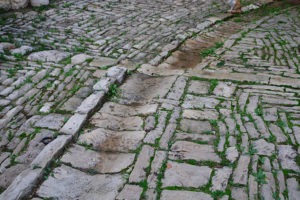Visiting the Hamadeh Palace in the picturesque village of Baakline perched on Lebanon’s Shouf mountains is an unforgettable experience.
As you step over the threshold, Talaat Hamadeh, one of the palace’s inheritors and a descendant of the original family, immediately transports you back in time. As you listen to the sound of Talaat’s voice, you will stop to wonder whether he had been there first, back in the time of Maan princes, or if the intricate arches had first laid their foundations to one day accommodate, the most timeless, peaceful and elegant hosts you could encounter. (The Emir Fakhr-al-Din ibn Maan being the 1st prince of the State of Lebanon between the 17th and 19th centuries under the Ottoman Empire).

Talaat will then invite you to enter a sea blue walled room, bearing the portraits of the three members of the Hamadeh family who held the position of “Sheikh Akl”, the spiritual leader of the Druze sect. The room is flooded with an exquisite yet discreetly revealing light that unleashes visions of gathered elders discussing, over a cup of hot tea from the stove, matters of importance to the community. On the right side wall, a door, or more precisely an opening through thick walls, leads you to a surprise.
You will pause to decide if you are entering a real room or if Talaat is allowing you the privilege to see a reflection of the timeless personal space he inhabits. In here, Talaat has accumulated objects of the past and he smiles while watching you react to the story they tell our collective memory. Nested with other personal remembrances you thought were gone forever, an old radio awakens tunes of Oum Koulthoun’s Thursday night songs from their deep sleep. Although you were total strangers before entering this shrine to time he has painstakingly protected for years, Talaat has managed to connect with you.
Besides reception rooms that house objects collected from around the estate and portraits of the Hamadeh family, Talaat will eventually lead you into a long and slender room where supporting arches challenge each other to reflect skilled craftsmanship and a sense of strength, stability and security. He has ridden the walls of the arches of their inner coat and the stone appears to play with the light coming in from narrow windows on the sidewalls. Talaat has not yet decided what he wants to do with the room. He is thinking of transforming it into a museum showcasing more objects found on the estate. The room could easily be a venue for committee meetings, concerts or art installations.
Talaat will then lead you to the main entrance of the estate, passing through a paved way that dates back a few hundred years. The location of the rings, used to tie horses in the courtyard, are still visible. The entrance door with its metal inserts opens onto the internal reception courtyard where Talaat’s elders used to gather, seated on stone benches lining the sidewalls.
The visit will probably conclude with a cup of coffee in the courtyard surrounded by flourishing vegetation in summer, or with a cup of hot tea from the stove in Talaat’s office in winter. The door he opens for you is adorned with brightly colored patterns that were in fashion centuries ago. Talaat will take you on a trip through history and will tell you the story of these old stones that have survived time trapping him in their embrace. What a wonderful way to make the country’s history come alive.

The visit is free of charge.
Article edited on November 17, 2021
Loading




